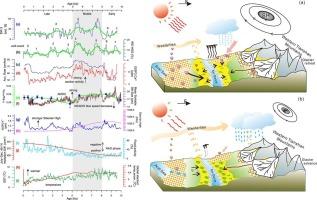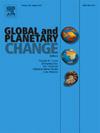New insights into Holocene dust activity in eastern Uzbekistan
IF 4
1区 地球科学
Q1 GEOGRAPHY, PHYSICAL
引用次数: 0
Abstract
Central Asia is a substantial source of long-range-transported dust, yet the historical and geological variability of dust activity in this region remains poorly understood. This study presents a Holocene record of dust activity from a 6.2-m loess section located near Tashkent in the westerlies-dominated region of eastern Uzbekistan, Central Asia. Utilizing the quartz optically stimulated luminescence dating protocol, we employed grain-size analysis and trace-element geochemistry to reconstruct Holocene dust activity. Dating indicated that this section was deposited over the last 9.6 ka. Four grain-size end-member (EM) components were identified, each representing different atmospheric circulation patterns and sedimentary environments. End-member 2, with a modal size of 11.2 μm, likely represents particles transported by upper-level westerlies, while EM 3, with a modal size of 28.3 μm, is associated with near-surface winds linked to dust storms. Zirconium is concentrated in coarse particles, whereas Rb is enriched in finer particles during dust deposition. Therefore, higher Zr/Rb ratios indicate stronger or more distant dust transport; hence, the Zr/Rb ratio is a reliable indicator of dust activity. Holocene dust activity was reconstructed using the EM 3 component and Zr/Rb ratio, revealing several extreme dust-storm events. During the early–middle Holocene (9.6–5 ka), dust activity was stronger but less frequent compared with the subsequent shift to lower intensity but higher frequency dust events. The long-term orbital-scale decline in Holocene dust activity can be attributed to reduced solar insolation and weakening of the Siberian High since the early Holocene. On a centennial to millennial scale, extreme dust-storm events are teleconnected with cold ice-rafted debris events in the North Atlantic. Projections for the coming century suggest that dust activity in eastern Uzbekistan may further decline, accompanied by an increase in precipitation. This study provides new insights into understanding and predicting dust storms in Central Asia.

乌兹别克斯坦东部全新世沙尘活动的新发现
中亚是远距离传播沙尘的一个重要来源,但人们对这一地区沙尘活动的历史和地质变化仍然知之甚少。本研究展示了中亚乌兹别克斯坦东部西风主导地区塔什干附近一个 6.2 米黄土断面的全新世沙尘活动记录。利用石英光学激发发光测年协议,我们采用粒度分析和痕量元素地球化学方法重建了全新世的尘埃活动。测年结果表明,该剖面沉积于过去的 9.6 ka。我们确定了四种颗粒大小的末端分子(EM)成分,它们分别代表了不同的大气环流模式和沉积环境。末端成分 2 的模态尺寸为 11.2 μm,可能代表了由高层西风输送的颗粒;而 EM 3 的模态尺寸为 28.3 μm,与沙尘暴相关的近地表风有关。锆富集在粗颗粒中,而铷富集在尘埃沉积过程中的细颗粒中。因此,Zr/Rb比率越高,表明尘埃迁移越强或越远;因此,Zr/Rb比率是尘埃活动的可靠指标。利用 EM 3 分量和 Zr/Rb 比率重建了全新世的沙尘活动,揭示了几个极端沙尘暴事件。在全新世早中期(9.6-5 ka),沙尘活动强度较大,但频率较低,而随后的沙尘事件强度较低,但频率较高。全新世沙尘活动在轨道尺度上的长期下降可归因于自全新世早期以来太阳日照减少和西伯利亚高纬度的减弱。在百年到千年尺度上,极端沙尘暴事件与北大西洋的寒冷冰雪碎片事件存在着千丝万缕的联系。对下个世纪的预测表明,乌兹别克斯坦东部的沙尘活动可能会进一步减少,同时降水量也会增加。这项研究为了解和预测中亚沙尘暴提供了新的视角。
本文章由计算机程序翻译,如有差异,请以英文原文为准。
求助全文
约1分钟内获得全文
求助全文
来源期刊

Global and Planetary Change
地学天文-地球科学综合
CiteScore
7.40
自引率
10.30%
发文量
226
审稿时长
63 days
期刊介绍:
The objective of the journal Global and Planetary Change is to provide a multi-disciplinary overview of the processes taking place in the Earth System and involved in planetary change over time. The journal focuses on records of the past and current state of the earth system, and future scenarios , and their link to global environmental change. Regional or process-oriented studies are welcome if they discuss global implications. Topics include, but are not limited to, changes in the dynamics and composition of the atmosphere, oceans and cryosphere, as well as climate change, sea level variation, observations/modelling of Earth processes from deep to (near-)surface and their coupling, global ecology, biogeography and the resilience/thresholds in ecosystems.
Key criteria for the consideration of manuscripts are (a) the relevance for the global scientific community and/or (b) the wider implications for global scale problems, preferably combined with (c) having a significance beyond a single discipline. A clear focus on key processes associated with planetary scale change is strongly encouraged.
Manuscripts can be submitted as either research contributions or as a review article. Every effort should be made towards the presentation of research outcomes in an understandable way for a broad readership.
 求助内容:
求助内容: 应助结果提醒方式:
应助结果提醒方式:


